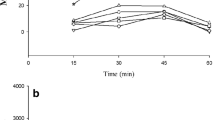Abstract.
Rationale: Several lines of evidence indicate that central opioid systems may be involved in the behavioral effects of nicotine. We previously reported that mecamylamine-precipitated nicotine-withdrawal aversion can be evaluated using the conditioned place preference paradigm. Objectives: In the present study, modulation of opioidergic systems in mecamylamine-precipitated nicotine-withdrawal aversion was investigated. Methods: Male Sprague-Dawley rats were chronically treated s.c. with 10 mg/kg/day (–)-nicotine tartrate using an osmotic minipump. After nicotine treatment for 7 days, conditioning sessions were performed. In the morning, the rats were treated with mecamylamine (0.3–3.0 mg/kg, s.c.), hexamethonium (1.0–3.0 mg/kg, s.c.), naloxone (0.1–1.7 mg/kg), or saline (1.0 ml/kg, s.c.) in one compartment for 60 min. In the evening of the same day, rats were treated with the other treatments and confined to the other compartment for 60 min. Rats were treated with morphine (3.0 mg/kg, s.c.) or TAN-67 (56.0 mg/kg, s.c.) 30 min prior to mecamylamine injection in the conditioning session. On the next day of conditioning, tests were performed. Results: Mecamylamine, which is known to pass the blood–brain barrier, produced a dose-dependent place aversion. However, hexamethonium, which fails to penetrate the blood–brain barrier, failed to produce a place aversion. Mecamylamine-precipitated nicotine-withdrawal aversion was significantly attenuated by pretreatment with the µ-opioid receptor agonist morphine and the highly selective δ-opioid receptor agonist TAN-67, which was administered 30 min before mecamylamine injection in the conditioning session. Moreover, naloxone at doses (0.1–1.7 mg/kg) that alone failed to show a place aversion in non-treated rats, produced a dose-dependent place aversion in rats that had been chronically treated with nicotine. Conclusions: These results suggest that central opioid systems may be involved in nicotine-withdrawal aversion.
Similar content being viewed by others
Author information
Authors and Affiliations
Additional information
Electronic Publication
Rights and permissions
About this article
Cite this article
Ise, Y., Narita, M., Nagase, H. et al. Modulation of opioidergic system on mecamylamine-precipitated nicotine-withdrawal aversion in rats. Psychopharmacology 151, 49–54 (2000). https://doi.org/10.1007/s002130000482
Received:
Accepted:
Issue Date:
DOI: https://doi.org/10.1007/s002130000482




